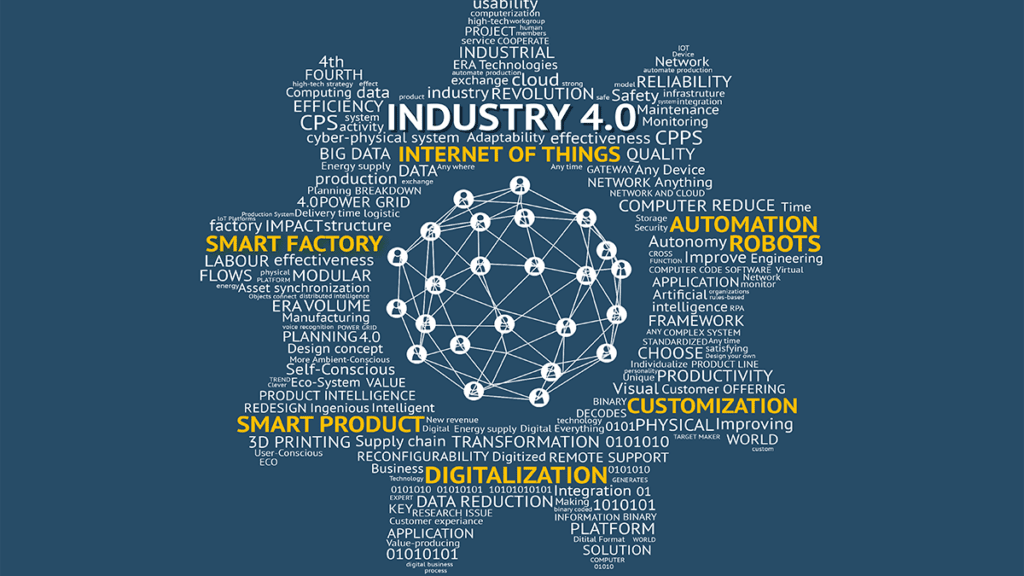
Industry 4.0 – Also known as the 4th industrial revolution, is a leap into everything digital. It embraces a new industrial revolution through intelligent and self-reliant technologies. Its aim is to connect the digital world with the physical one and phase out any boundaries between the two. With the support of connectivity it is a mix of progress in artificial intelligence (AI), robotics, the internet of things (IoT), blockchain, 3D printing, quantum computing and numerous other technologies.
The idea is that the Fourth Industrial Revolution builds on the previous ones. However, there are two factors which make it significantly unique.
• The rate of change is exponential.
• The substantially expanded scope disrupts all industry sectors and impacts them deeply.
Industry 4.0’s real opportunity is not simply technology or change that comes from technology, it is unlocking the full potential of digitalisation and harnessing it to impact society positively. To make the most of opportunities that come from Industry 4.0, companies need to integrate new digital technologies and capabilities into their business processes and policies. This is known as digital transformation. Businesses and societies tend to go through this once every decade, but this is on a new level entirely.
Something that has increased with each transformation is that of digital risk, meaning the risk that is associated with digital business processes. Digital risk is not just a technological problem, but a fundamental business concern too. Knowing how to manage such risks means a better understanding of what causes it.
Those organisations that were founded before the rise of all that is digital are chasing digital maturity. In this pursuit, they are engaging with digital transformation and once the company acquires this and integrates it, they are considered digitally mature. Digital maturity does not mean getting to the end, it means constantly evolving with the new opportunities that technology brings – now, more rapidly than ever. An organization’s failure to do this, can result in stagnation, which will inevitably prevent the advancement of business processes and more importantly, revenue.
Digital maturating is concerned with the integration of a company’s operations and human capital into digital processes.
According to MIT, digital transformation is “about how technology changes the conditions under which business is done, in ways that change the expectations of customers, partners and employees.” And although the majority of organizations are on the journey to digital maturity, no one has reached that point yet. The reason being, digital transformation requires a massive overhaul to see and implement the technology in the core of the organisation. It needs all of the appropriate technology, but this is just the first phase of such a process.
Managing the issue and ever-evolving threat of cybersecurity is considered one of industry 4.0’s most imperative challenges to overcome. The digitization that comes with the transformation increases a business’s susceptibility to cyberattacks – protecting a vast range of connected platforms, networks, hardware and software is becoming increasingly difficult.
The development of a company’s digital surface is an automatic increase digital risk and thus explains why cyber security is vital for all organisations. It is the protection of today’s commodity against theft unauthorized access and any online abuse.
The right amount of attention needs to be given to both cybersecurity and digital risk and it should be included in company’s strategy and road map. Cyberattacks have gone up substantially as those that understand the power are able to misuse data for various purposes such as financial or political gain.
Any digital transformation path begins with a strategy that incorporates cybersecurity components that are necessary to ensure that risk is managed accordingly.
Companies also need to assess risk beyond traditional risk and security. Organisations should have clarity and understand their digital footprint, creating methods to measure and record digital risk. One example of this is social media platforms, which many businesses have adopted as a means of marketing. Social media comes with its own set of digital risk that can impact company brand and reputation.
Business strategy should include necessities like detection and response functions but also focus on prevention. However, with all the prevention efforts in the world, unexpected events can still occur.
Digital transformation is critical for sectors to stay both competitive and relevant. Finding and incorporating new ways to adopt digital processes can open numerous opportunities but it is important to use these opportunities in a safe and secure way by including cybersecurity as part of your transformation program.